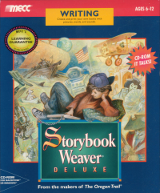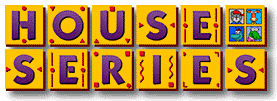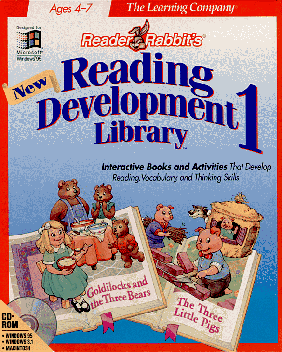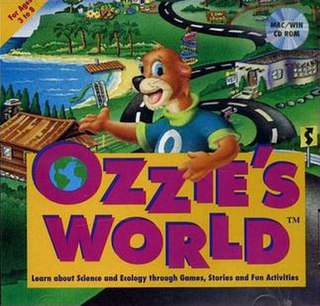Related Research Articles
JumpStart is an educational media franchise for children, consisting mostly of educational games, produced by JumpStart Games. The series originally consisted of a series of educational PC games but has since expanded to include workbooks, direct-to-video films, mobile apps, and other media, including a massive multiplayer online game located at JumpStart.com, that were launched on March 10, 2009.

Living Books is a series of interactive read-along adventures aimed at children aged 3–9. Created by Mark Schlichting, the series was mostly developed by Living Books for CD-ROM and published by Broderbund for Mac OS and Microsoft Windows. Two decades after the original release, the series was re-released by Wanderful Interactive Storybook for iOS and Android.

Storybook Weaver is a 1994 educational game released on floppy disk for the Apple Macintosh, aimed at children aged 6–12. An updated version, Storybook Weaver Deluxe, was released for Windows and Mac computers and featured much more content than the original. Both versions were released by MECC. The Deluxe version was made available for both home and school environments. A Teacher Resource CD for the software included lesson plans and user guides.
An interactive storybook is a children's story packaged with animated graphics, sound or other interactive elements. Such stories are usually published as software on CD-ROMs. They have also been referred to as computer books, picture book programs, books-on-disk, talking books, or living books.

Arthur's Teacher Trouble is a book in the Arthur series, released in 1986. It was written by Marc Brown and published by Little, Brown and Company and The Living Books Company.
Mark Schlichting is a publisher, author, and digital pioneer of children's multimedia and interactive design software. He is best known as the creator and subsequent Design and Art Director of Broderbund's Living Books series, one of the first lines of children's interactive book software on CD-ROM. Schlichting was Design and Art Director for Living Book's first interactive CD-ROM book adaptation, Mercer Mayer’s Just Grandma and Me, which was one of the first software titles accredited as a school textbook and used as a product demonstration by Apple CEO John Sculley.
There have been a variety of Sesame Street video games released for video game platforms. Most of the Sesame Street video games were published and developed by NewKidCo.
The Magic School Bus is a series of educational software video games developed by Music Pen and published by Microsoft via their Microsoft Home brand. The interactive adventures are part of the larger franchise and based on The Magic School Bus book series and public television series.

Disney's Animated Storybook is a point-and-click adventure interactive storybook video game series based on Walt Disney feature animations and Pixar films that were released throughout the 1990s. They were published by Disney Interactive for personal computers for children ages four to eight years old. Starting from 1994, most of the entries in the series were developed by Media Station. They have the same plots as their respective films, though abridged due to the limited medium.
Headbone Interactive, Inc. was an American children-oriented multimedia company located in Seattle, Washington founded around 1993–1994 by Susan Lammers and her husband Walter Euyang. The company folded in October 2001 when their official website went offline.

Early Learning House is a collection of four main educational video games and two compilations for the Windows and Macintosh platforms, developed by Theatrix Interactive, Inc. and published by Edmark software. Each different game focuses on a particular major learning category with selectable skill settings for preschooler, kindergarten and elementary learners. Millie's Math House (1992) on mathematics, Bailey's Book House (1993) on language, Sammy's Science House (1994) on science, and Trudy's Time and Place House (1995) on history and geography. A spin-off, Stanley's Sticker Stories (1996), sees players create animated storybooks with the series' characters. Millie & Bailey Preschool and Millie & Bailey Kindergarten each contain the combined activities from two of the four software products. In addition the programs can be configured by an adult mode to suit students with special needs. Most of the activities in every game have two modes, one to allow learners to explore and try it out for themselves and the other for learners to follow specific tasks set by the game characters. Learners also have the option to print pictures of creative activities and record sounds in phonics activities. Later the games were re-developed by Houghton Mifflin Harcourt Learning Technology and re-published by The Learning Company with newer graphics and additional activities.

Jewels of the Oracle is a 1995 adventure game developed by ELOI Productions and published by Discis Knowledge Research Inc. It was released on Macintosh, PlayStation, Sega Saturn, and Windows. A sequel developed by Bardworks and published by Hoffman and Associates was released in 1998 entitled Jewels II: The Ultimate Challenge.
Magic Tales is a series of interactive storybooks for children, developed by Animation Magic and produced by Davidson, which were distributed by Capitol Multimedia, Inc. on CD-ROM for Mac OS and Microsoft Windows. The series was introduced at the 1995 MacWorld trade show. The series began with the release of Baba Yaga and the Magic Geese in 1995. The stories are narrated by the central character Grandpa Mouse, who reads them to his two grandchildren while they are having a boring time. The series was titled "El Abuelo Ratón" in Spanish. Each story has twelve pages.
The Kidstory Series is a series of six interactive storybooks for children, developed by Brilliant Interactive Ideas and produced by Active Imagination on CD-ROM for Mac OS and Microsoft Windows. The stories are narrated by the host Mick. Glen Uslan, the Vice President of Active Imagination, intended the products to be affordable for customers, while retaining good quality. The company intended to have a total of 15 titles produced by the end of the year. By 1996, the company invested around $400,000 in additional titles.

Reader Rabbit's Reading Development Library is a series of four edutainment games from The Learning Company as part of the Reader Rabbit franchise. The first two games were developed in October 1994, the third was developed in 1995 and the last one was developed in 1996. The products make use of interactive storybooks based on fairy tales to help early readers broaden their reading, vocabulary, writing and word recognition skills. Each number in the title corresponds to the reading level of the reader they are aimed at.

Reader Rabbit's Interactive Reading Journey is a 1994 video game released on the Windows and Macintosh systems. It is the sixth game in the Reader Rabbit franchise. Designed for ages 4 till 7, the game introduces the new main characters Mat the Mouse and Sam the Lion who accompany Reader. It was then re-released in 1997 under the title "Reader Rabbit's Interactive Reading Journey For Grades K-1", followed by another in 1998 titled "Reader Rabbit's Reading Ages 4–6" and a personalized version in 1999.

Ozzie is a series of children's educational games developed by Tulsa, Oklahoma studio Digital Impact. They all star Ozzie S. Otter, a curious and imaginative young 7-year-old orphaned sea otter pup who serves as the series' main protagonist. The games focus on teaching children science and ecology in different environments. They also include several activities, stories, mini games and experiments to try out.

Magic Fairy Tales: Barbie as Rapunzel is a 1997 educational adventure game developed by Media Station and published by Mattel Media.

Europress Bookshelf is a series of interactive storybooks for children, developed by Europress Software and published by Q Range on CD-ROM for Mac OS and Windows, using their own games creator Klik & Play to produce the products with minimal programming. The games came under three series including "Read & Play" for younger readers, "Topsy and Tim" based on the Adamson books and "Living Classics".

Rugrats Adventure Game is an educational adventure point and click video game based on the Rugrats television series released for Microsoft Windows and Macintosh on September 30, 1998. It was developed and published by Broderbund. The game follows Tommy Pickles and friends Chuckie, Phil, and Lil as they try to rescue Tommy's beloved toy Reptar from being thrown out as garbage. The game incorporates point and click gameplay, with characters and objects appearing in different locations even after the player has visited them once. Angelica, the series' main antagonist, appears in the game to help further the story and ultimately become the game's main villain.
References
- 1 2 3 4 "Discis branches out to multi-format 'books'". strategy. 1993-03-08. Retrieved 2020-10-27.
- ↑ https://files.eric.ed.gov/fulltext/ED392069.pdf [ bare URL PDF ]
- ↑ MacUser (PDF). December 1994. p. 92.
- ↑ "Best PC for Families May be No PC". 17 December 1992.
- ↑ "Fail Safe?". EW.com. Retrieved 2020-10-30.
- 1 2 3 4 "Discis intros 'Kids Basics' CD-ROMs". strategy. 1994-03-07. Retrieved 2020-10-27.
- ↑ https://vintageapple.org/macuser/pdf/MacUser_9412_December_1994.pdf [ bare URL PDF ]